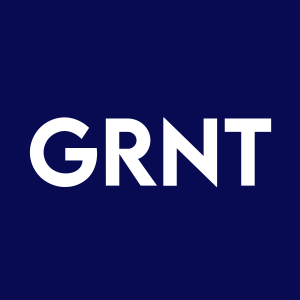Welcome to our dedicated page for Granite Ridge Resources SEC filings (Ticker: GRNT), a comprehensive resource for investors and traders seeking official regulatory documents including 10-K annual reports, 10-Q quarterly earnings, 8-K material events, and insider trading forms.
Commodity price swings, reserve calculations, and joint-venture accounting can turn Granite Ridge Resources’ disclosures into a maze. If you have ever opened the 300-page 10-K and wondered where the proved reserve table or hedging footnote hides, you are not alone. Investors search daily for “Granite Ridge Resources SEC filings explained simply”, yet still spend hours digging for answers.
That’s why Stock Titan pairs every document with AI-powered summaries that highlight what matters—whether it’s production growth in a Granite Ridge quarterly earnings report 10-Q filing or a sudden impairment noted in an 8-K material events explained. Our engine extracts:
- Real-time alerts on Granite Ridge Form 4 insider transactions and executive stock sales
- Segment-level cash flow trends from each 10-Q
- Reserve revisions and commodity hedges buried deep in the annual report
Common questions we answer on a single screen:
- “How did production volumes shift this quarter?”—see the Granite Ridge earnings report filing analysis
- “Which directors bought shares?”—check Granite Ridge insider trading Form 4 transactions
- “What’s new in the proxy?”—our AI decodes the Granite Ridge proxy statement executive compensation
Behind the scenes, our system scans EDGAR every few minutes, so you view Granite Ridge Resources Form 4 insider transactions real-time and get notified the moment a new filing drops. Need to dive deeper? Click any section tag—production costs, environmental obligations, partner working interests—and jump straight to the paragraph in the source PDF. Understanding Granite Ridge SEC documents with AI means fewer hours scrolling and more time making decisions.
Stop downloading hefty PDFs. Explore the Granite Ridge annual report 10-K simplified, watch each Granite Ridge 8-K in context, and act on insights the moment they matter.
Granite Ridge Resources, Inc. (GRNT)11/21/2025, the reporting person bought 5,000 shares of common stock at $4.95 per share and another 5,000 shares at $5.00 per share. These were reported as acquisitions of non-derivative common stock.
After these transactions, the director beneficially owns 1,051,997 shares of Granite Ridge common stock in direct ownership form. The filing does not report any derivative securities activity, and the person is identified as a director rather than an officer or 10% owner.
Granite Ridge Resources, Inc. (GRNT) director John McCartney reported open market purchases of company stock. On 11/18/2025, he bought 4,000 shares of common stock at a price of $5.07 per share. On 11/19/2025, he bought an additional 4,000 shares at $5.05 per share. Following these transactions, he beneficially owned 103,091 shares of Granite Ridge common stock in direct ownership.
Granite Ridge Resources, Inc. (GRNT)
Granite Ridge Resources, Inc. director reports open-market share purchase. A company director bought 4,000 shares of Granite Ridge Resources common stock on 11/13/2025 at a price of $5.17 per share. After this transaction, the director beneficially owns 91,091 shares of common stock, held as a direct ownership position. The filing is made on Form 4, which reports changes in the equity holdings of insiders subject to Section 16 reporting rules.
Granite Ridge Resources (GRNT) disclosed an insider purchase on a Form 4. A director bought 4,000 shares of common stock on 11/11/2025 at a price of $5.26 per share (transaction code P). Following this trade, the reporting person beneficially owns 87,091 shares, held as direct ownership.
Granite Ridge Resources (GRNT) reported Q3 2025 results with revenue of $112.7 million, up from $94.1 million a year ago, and net income of $14.5 million ($0.11 diluted EPS) versus $9.1 million ($0.07) in Q3 2024. Year to date, revenue reached $344.8 million with net income of $49.4 million ($0.38 diluted EPS).
Operating cash flow for the first nine months was $231.9 million, funding $233.1 million of capital expenditures and $57.0 million of acquisitions. Long‑term debt rose to $300.0 million under the revolving credit facility; the borrowing base and elected commitments were increased to $375.0 million in April, leaving $74.7 million available at quarter‑end. The company paid a $0.11 per‑share dividend in the quarter and declared another $0.11 for the fourth quarter.
Commodity hedges as of September 30 included Q4 2025 oil collars on 698,000 Bbl (floor $60.00, ceiling $77.13) and natural gas collars/swaps covering 4.65 Bcf total across instruments. Subsequent to quarter‑end, Granite Ridge issued $350.0 million of 8.875% senior unsecured notes due 2029 at 96.0% of par and used proceeds to repay borrowings under the credit facility; the credit agreement was amended to extend its maturity and align terms.
Granite Ridge Resources (GRNT) furnished Q3 2025 materials. The company issued a press release announcing financial and operating results for the quarter ended September 30, 2025, and made an Investor Presentation available on its website.
The press release was furnished as Exhibit 99.1, and the information in this report, including Exhibit 99.1, is being furnished and not filed under the Exchange Act.
Matthew Reade Miller, a director of Granite Ridge Resources, Inc. (GRNT), acquired 3,466 shares of the company's common stock on 09/30/2025 as payment in lieu of the quarterly cash retainer under the issuer's Board compensation plan. The shares were issued based on the closing price on 09/30/2025. After the transaction, Mr. Miller beneficially owned 1,288,130 shares. The Form 4 was signed by Emily Fuquay by power of attorney and filed on 10/01/2025.
Granite Ridge Resources director Matthew Reade Miller reported a purchase of 600 shares of the company's common stock on 09/15/2025 at a reported price of $5.35 per share. The acquisition was coded as a purchase via automatic dividend reinvestment through a brokerage account. Following the transaction, Mr. Miller is shown as beneficially owning 1,284,664 shares. The Form 4 was signed under power of attorney by Emily Fuquay on 09/17/2025. No derivative securities or other transactions are reported on this filing.
John McCartney, a director of Granite Ridge Resources, Inc. (GRNT), reported a non-derivative purchase of 974 shares of common stock on 08/21/2025 at a reported price of $5.30 per share. Following the transaction he beneficially owns 83,091 shares. The Form 4 was signed by Emily Fuquay by power of attorney on 08/25/2025. The filing identifies McCartney as a director and indicates the Form was filed by one reporting person.


